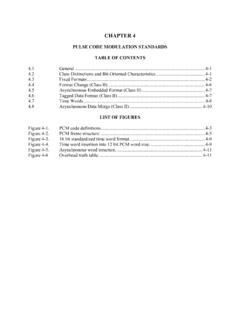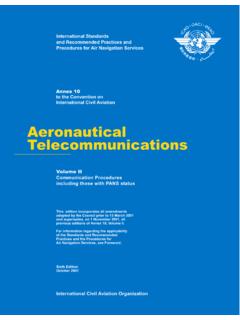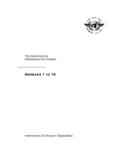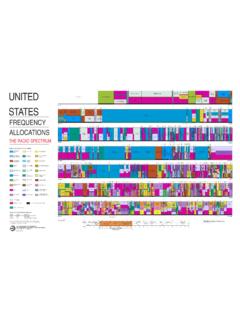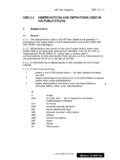Transcription of TRANSMITTER AND RECEIVER SYSTEMS - IRIG 106
1 Telemetry Standards, IRIG Standard 106-13 (Part 1), Chapter 2, June 2013 CHAPTER 2 TRANSMITTER and RECEIVER SYSTEMS Acronyms .. 2- iii Radio Frequency Standards for Telemetry .. 2- 1 2- 1 2- 1 Allocation of the Lower L-Band (1435-1535 MHz).. 2- 2 Allocation of the Lower S-Band (2200 to 2300 MHz).. 2- 3 Allocation of the Upper S-Band (2310 to 2395 MHz).. 2- 3 Allocation of the Lower C-Band (4400-4940 MHz) .. 2- 3 Allocation of the Middle C-Band (5091-5150 MHz) .. 2- 3 Allocation of the Upper C-Band (5925-6700 MHz) .. 2- 4 Telemetry TRANSMITTER SYSTEMS .. 2- 4 Center Frequency Tolerance .. 2- 4 Output Power .. 2- 4 Modulation .. 2- 4 Spurious Emission and Interference Limits .. 2- 13 Operational Flexibility.
2 2- 13 Modulated TRANSMITTER Bandwidth.. 2- 14 Valid Center Frequencies Near Telemetry Band Edges .. 2- 14 Telemetry RECEIVER 2- 15 Spurious Emissions .. 2- 15 Frequency Tolerance .. 2- 15 RECEIVER Phase Noise .. 2- 15 Spurious Responses .. 2- 15 Operational Flexibility .. 2- 15 Intermediate Frequency Bandwidths .. 2- 15 C-band Downconversion .. 2- 16 Appendix 2-A. Glossary .. 2- 17 Appendix 2-B. References .. 2- 18 List of Figures Figure 2-1. FQPSK-JR baseband signal generator .. 2- 6 Figure 2-2. Basic SOQPSK .. 2- 8 Figure 2-3. SOQPSK 2- 10 Figure 2-4. Conceptual CPM Modulator .. 2- 11 Figure 2-5. Continuous single sideband phase noise power spectral density .. 2- 12 Telemetry Standards, IRIG Standard 106-13 (Part 1), Chapter 2, June 2013 2-ii List of Tables Table 2-1.
3 Telemetry Frequency Allocations .. 2- 1 Table 2-2. FQPSK-JR Shaping Filter Definition .. 2- 7 Table 2-3. FQPSK-B and FQPSK-JR Phase Map .. 2- 8 Table 2-4. SOQPSK-TG Parameters .. 2- 10 Table 2-5. SOQPSK Pre-Coding Table for IRIG-106 Compatibility .. 2- 10 Table 2-6. Dibit to Impulse Area Mapping .. 2- 11 Table 2-7. Standard RECEIVER Intermediate Frequency Bandwidths .. 2- 15 Telemetry Standards, IRIG Standard 106-13 (Part 1), Chapter 2, June 2013 2-iii Acronyms V microvolt ARTM Advanced Range Telemetry CPFSK continuous phase frequency shift keying CPM continuous phase modulation dB decibel dBc decibels relative to the carrier dBm decibel referenced to one milliwatt EIRP effective isotropic radiated power FM frequency modulation FQPSK Feher s quadrature phase shift keying GHz gigahertz Hz hertz IF intermediate frequency kHz kilohertz Mb/s megabit per second MHz megahertz MIL-STD Military Standard NRZ-L non-return-to-zero-level NTIA National Telecommunications and Information Administration OQPSK offset quadrature phase shift keying PCM pulse code modulation PSD power spectral density RF radio frequency RFC radio frequency channel SOQPSK shaped offset
4 Quadrature phase shift keying Telemetry Standards, IRIG Standard 106-13 (Part 1), Chapter 2, June 2013 2- iv This page intentionally left blank. Telemetry Standards, IRIG Standard 106-13 (Part 1), Chapter 2, June 2013 2-1 CHAPTER 2 TRANSMITTER and RECEIVER SYSTEMS Radio Frequency Standards for Telemetry These standards provide the criteria to determine equipment and frequency use requirements and are intended to ensure efficient and interference-free use of the radio frequency spectrum. These standards also provide a common framework for sharing data and providing support for test operations between ranges. The radio frequency spectrum is a limited natural resource; therefore, efficient use of available spectrum is mandatory.
5 In addition, susceptibility to interference must be minimized. SYSTEMS not conforming to these standards require justification upon application for frequency allocation, and the use of such SYSTEMS is highly discouraged. The standards contained herein are derived from the National Telecommunications and Information Administration s (NTIA) Manual of Regulations and Procedures for Federal Radio Frequency Definitions As of RCC 106-13 published June 2013, the definitions that in previous versions comprised this section are now located in Appendix 2-A, one of two appendices new to this publication. Bands The bands used for telemetry are described unofficially below. Additional detail can be seen at Table 2-1. Lower L-band 1435 - 1535 megahertz (MHz) Lower C-band 4400 - 4940 MHz Lower S-band 2200 - 2290 MHz Middle C-band 5091 - 5150 MHz Upper S-band 2310 - 2395 MHz Upper C-band 5925 - 6700 MHz Table 2-1.
6 Telemetry Frequency Allocations Frequency Range (MHz) Unofficial Designation Comments Refer to: 1435-1525 Lower L-band Telemetry primary service (part of mobile service) in USA 1525-1535 Lower L-band Mobile satellite service (MSS) primary service, telemetry secondary service in USA 2200-2290 Lower S-band Telemetry co-primary service in USA 2310-2360 Upper S-band Wireless Communications Service (WCS) and broadcasting-satellite (sound) service (BSS) primary services, telemetry secondary service in USA 1 National Telecommunications and Information Administration. Manual of Regulations and Procedures for Federal Radio Frequency Management. May 2012. May be superseded by update.
7 Available at Telemetry Standards, IRIG Standard 106-13 (Part 1), Chapter 2, June 2013 2-2 2360-2395 Upper S-band Telemetry primary service in USA 4400-4940 Lower C-band See Paragraph 5091-5150 Middle C-band See Paragraph 5925-6700 Upper C-band See Paragraph The 1755-1850 MHz band (unofficially called upper L-band ) can also be used for telemetry at many test ranges although it is not explicitly listed as a telemetry band in the NTIA Table of Frequency The mobile service is a primary service in the 1755-1850 MHz band and telemetry is a part of the mobile service. Since the 1755-1850 MHz band is not considered a standard telemetry band per this document, potential users must coordinate, in advance, with the individual range(s) and ensure use of this band can be supported at the subject range and that it will meet their technical requirements.
8 While these band designations are common in telemetry parlance, they may have no specific meaning to anyone else. Telemetry assignments are made for testing3 manned and unmanned aircraft, for missiles, space, land, and sea test vehicles, and for rocket sleds and SYSTEMS carried on such sleds. Telemetry assignments are also made for testing major components of the aforementioned SYSTEMS . Allocation of the Lower L-Band (1435-1535 MHz). This band is allocated in the United States of America and its possessions for government and nongovernmental aeronautical telemetry use on a shared basis. The Aerospace and Flight Test Radio Coordinating Council coordinates the non-governmental use of this band. The frequencies in this range will be assigned for aeronautical telemetry and associated remote-control operations4 for testing of manned or unmanned aircraft, missiles, rocket sleds, and other vehicles or their major components.
9 Authorized usage includes telemetry associated with launching and reentry into the earth's atmosphere as well as any incidental orbiting prior to reentry of manned or unmanned vehicles undergoing flight tests. The following frequencies are shared with flight telemetering mobile stations: , , , , , and MHz. 1435 to 1525 MHz This frequency range is allocated for the exclusive use of aeronautical telemetry in the United States of America. 1525 to 1530 MHz The 1525 to 1530 MHz band was reallocated at the 1992 World Administrative Radio Conference. The mobile-satellite service is now a primary service in this band. The mobile service, which includes aeronautical telemetry, is now a secondary service in this band. 2 The definitions of the radio services that can be operated within certain frequency bands contained in the radio regulations as agreed to by the member nations of the International Telecommunications Union.
10 This table is maintained in the United States by the Federal Communications Commission and the NTIA and is available at 3A telemetry system as defined here is not critical to the operational (tactical) function of the system . 4 The word used for remote control operations in this band is telecommand. Telemetry Standards, IRIG Standard 106-13 (Part 1), Chapter 2, June 2013 2-3 1530 to 1535 MHz The maritime mobile-satellite service is a primary service in the frequency band from 1530 to 1535 The mobile service (including aeronautical telemetry) is a secondary service in this band. Allocation of the Lower S-Band (2200 to 2300 MHz). No provision is made in this band for the flight testing of manned aircraft. 2200 to 2290 MHz These frequencies are shared equally by the United States Government's fixed, mobile, space research, space operation, and the Earth Exploration Satellite Services, and include telemetry associated with launch vehicles, missiles, upper atmosphere research rockets, and space vehicles regardless of their trajectories.


